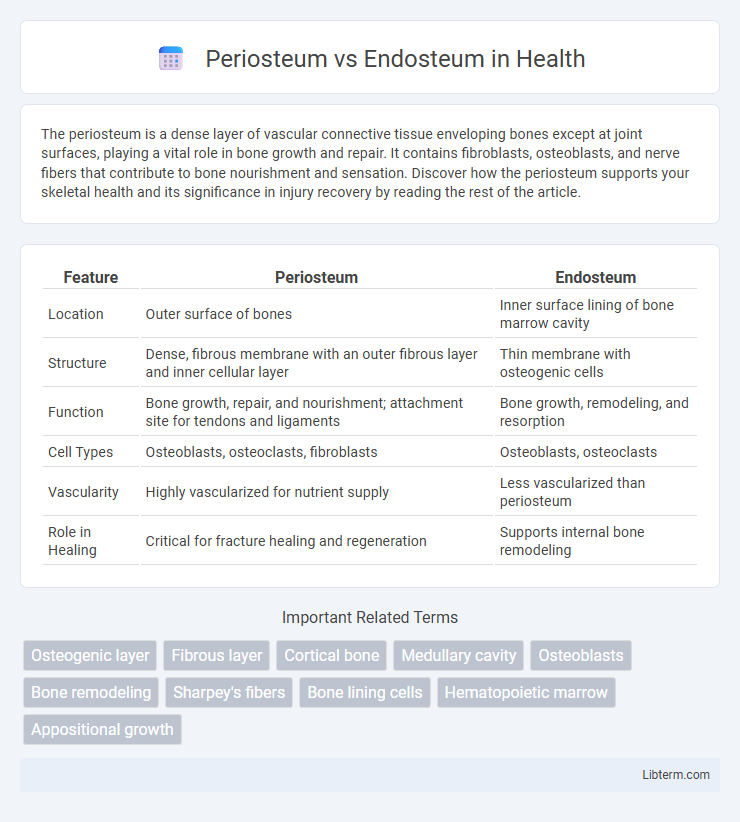The periosteum is a dense layer of vascular connective tissue enveloping bones except at joint surfaces, playing a vital role in bone growth and repair. It contains fibroblasts, osteoblasts, and nerve fibers that contribute to bone nourishment and sensation. Discover how the periosteum supports your skeletal health and its significance in injury recovery by reading the rest of the article.
Table of Comparison
| Feature | Periosteum | Endosteum |
|---|---|---|
| Location | Outer surface of bones | Inner surface lining of bone marrow cavity |
| Structure | Dense, fibrous membrane with an outer fibrous layer and inner cellular layer | Thin membrane with osteogenic cells |
| Function | Bone growth, repair, and nourishment; attachment site for tendons and ligaments | Bone growth, remodeling, and resorption |
| Cell Types | Osteoblasts, osteoclasts, fibroblasts | Osteoblasts, osteoclasts |
| Vascularity | Highly vascularized for nutrient supply | Less vascularized than periosteum |
| Role in Healing | Critical for fracture healing and regeneration | Supports internal bone remodeling |
Introduction to Periosteum and Endosteum
The periosteum is a dense, fibrous membrane covering the outer surface of bones, rich in blood vessels, nerves, and osteogenic cells essential for bone growth and repair. In contrast, the endosteum lines the inner surfaces of bone cavities, including the medullary cavity, and contains osteoprogenitor cells that contribute to bone remodeling and hematopoiesis. Both membranes play crucial roles in maintaining bone health, supporting structural integrity, and facilitating the dynamic process of bone regeneration.
Anatomical Location and Structure
The periosteum is a dense, fibrous membrane covering the outer surface of bones except at the joints, consisting of an outer fibrous layer and an inner osteogenic layer. The endosteum lines the inner surface of the bone cavity, including the medullary cavity and trabeculae of spongy bone, and is a thin, vascular membrane containing osteoprogenitor cells. Both play crucial roles in bone growth and remodeling, with the periosteum contributing to appositional growth and the endosteum involved in bone resorption and formation.
Cellular Composition
The periosteum consists of two layers: an outer fibrous layer rich in fibroblasts and an inner cambium layer containing osteoprogenitor cells that differentiate into osteoblasts for bone growth and repair. In contrast, the endosteum is a thin membrane lining the medullary cavity, composed mainly of osteoblasts, osteoclasts, and a sparse layer of osteoprogenitor cells involved in bone remodeling. Both tissues play critical roles in skeletal maintenance, with the periosteum primarily supporting external bone growth and the endosteum regulating internal bone resorption and formation.
Functions and Roles in Bone Physiology
The periosteum serves as a protective outer layer of bone, containing osteoblasts crucial for bone growth and repair, while facilitating nutrient delivery through its rich vascular network. The endosteum lines the inner surface of bone cavities, playing a key role in bone remodeling by housing osteoclasts that resorb bone tissue and osteoprogenitor cells that aid in bone regeneration. Together, the periosteum and endosteum coordinate to maintain bone homeostasis, support marrow activity, and regulate calcium and phosphate metabolism essential for skeletal health.
Periosteum: Key Features and Importance
Periosteum is a dense, fibrous membrane covering the outer surface of bones, playing a crucial role in bone growth, repair, and nutrient supply through its rich blood vessel network. It contains osteoblasts essential for new bone formation and acts as an attachment site for tendons and ligaments, providing structural stability. The periosteum's inner cambium layer supports bone regeneration, making it vital for healing fractures and maintaining overall skeletal health.
Endosteum: Key Features and Importance
Endosteum is a thin vascular membrane lining the inner surface of the bone, including the medullary cavity and trabeculae of spongy bone. It plays a crucial role in bone growth, remodeling, and repair by housing osteoprogenitor cells, osteoblasts, and osteoclasts responsible for bone resorption and formation. Its intimate involvement in maintaining bone homeostasis makes the endosteum essential for skeletal integrity and healing after injury.
Role in Bone Growth and Development
The periosteum is a dense connective tissue layer covering the outer surface of bones, playing a critical role in appositional growth by supplying osteoblasts for bone thickening and repair. In contrast, the endosteum lines the inner surfaces of bone cavities, contributing to longitudinal bone growth and remodeling through its population of osteoprogenitor cells. Both structures coordinate bone development by regulating the balance between bone formation and resorption essential for skeletal maintenance.
Participation in Bone Healing and Repair
The periosteum plays a critical role in bone healing by providing a rich source of osteoprogenitor cells and a vascular network essential for new bone formation. In contrast, the endosteum lines the inner bone surfaces and contributes to repair by activating osteoblasts and osteoclasts to remodel bone during the healing process. Both layers coordinate to rebuild bone structure, with the periosteum primarily driving external callus formation and the endosteum supporting internal bone remodeling.
Clinical Significance and Disorders
The periosteum, a dense vascularized membrane covering bone surfaces, plays a critical role in fracture healing and bone regeneration, with disorders such as periostitis causing pain and impaired bone growth. The endosteum lines the inner bone cavities, facilitating bone remodeling and hematopoiesis; diseases like osteoporosis and endosteal resorption disrupt its function, leading to weakened bone structure and increased fracture risk. Understanding the distinct clinical impacts of periosteal and endosteal pathology aids in targeted treatments for bone healing and metabolic bone diseases.
Summary: Key Differences and Similarities
The periosteum is a dense, fibrous membrane covering the outer surface of bones, rich in blood vessels and nerves, crucial for bone growth and repair, while the endosteum is a thin, vascular membrane lining the inner surface of the medullary cavity, mainly involved in bone remodeling. Both tissues contain osteoprogenitor cells essential for bone regeneration, but the periosteum plays a larger role in providing structural support and protection, whereas the endosteum primarily regulates bone resorption and formation within the marrow cavity. Together, these membranes maintain bone health by coordinating external growth and internal remodeling processes.
Periosteum Infographic

 libterm.com
libterm.com